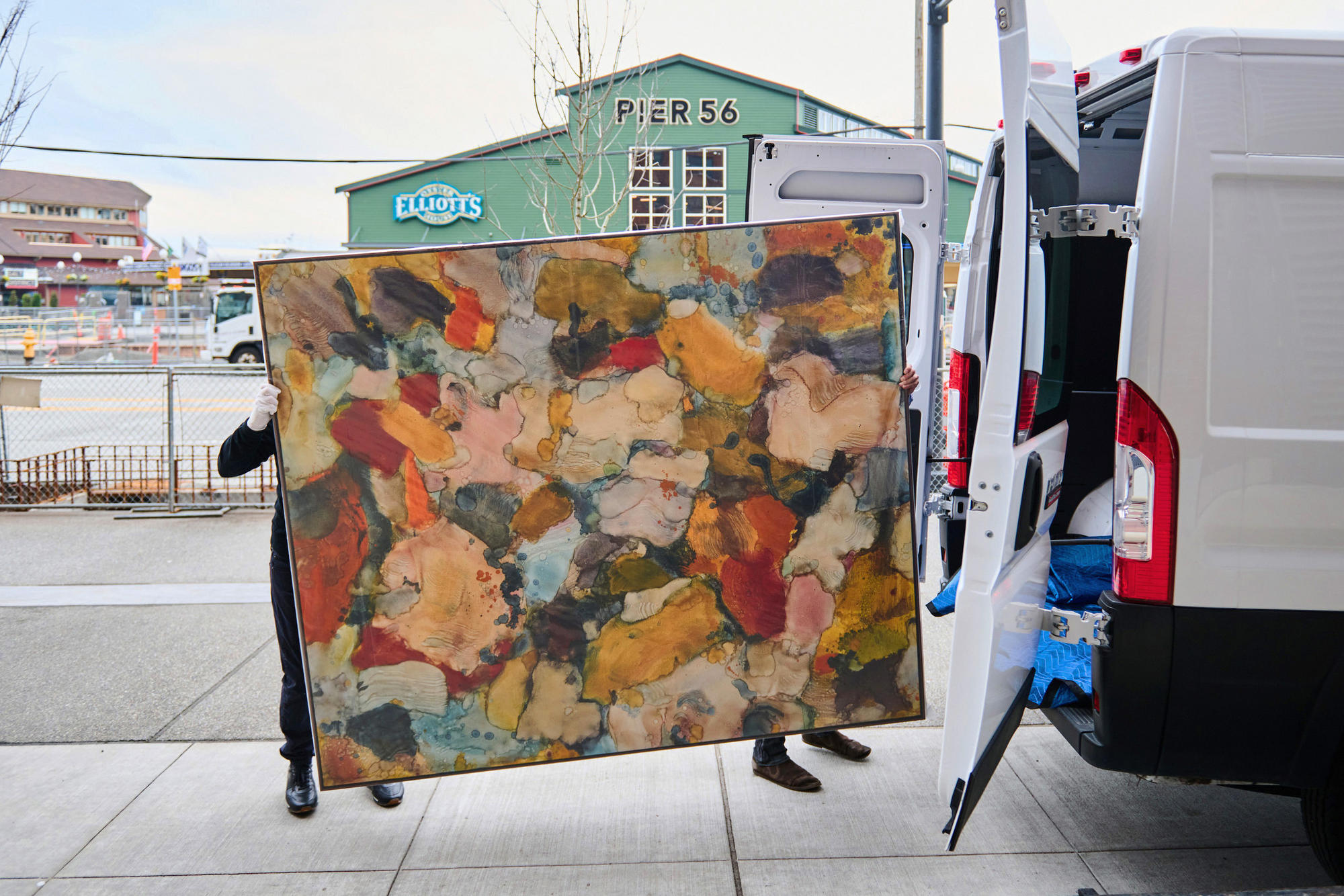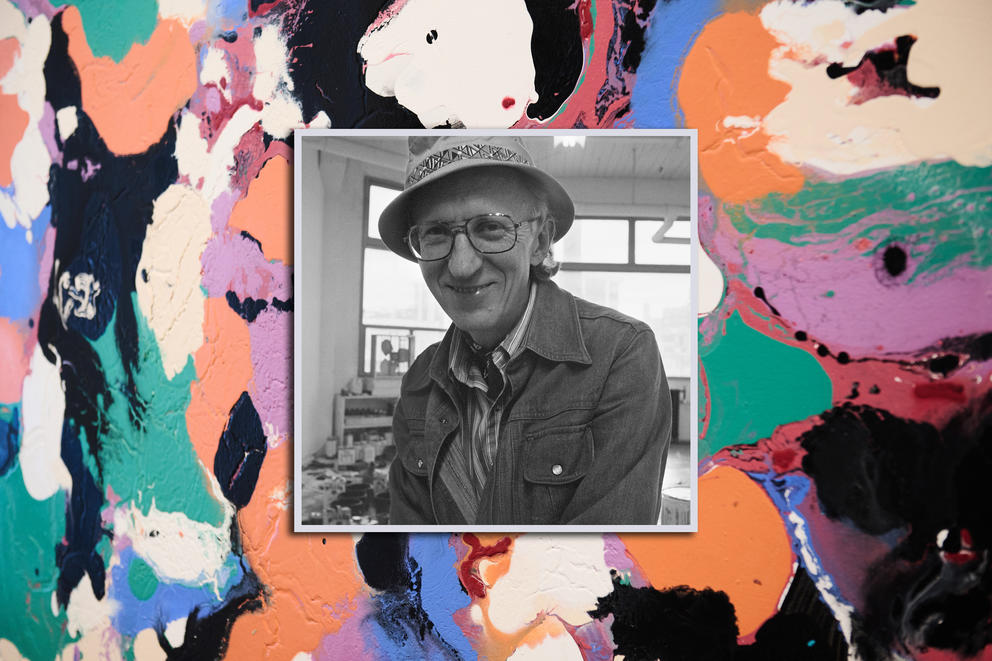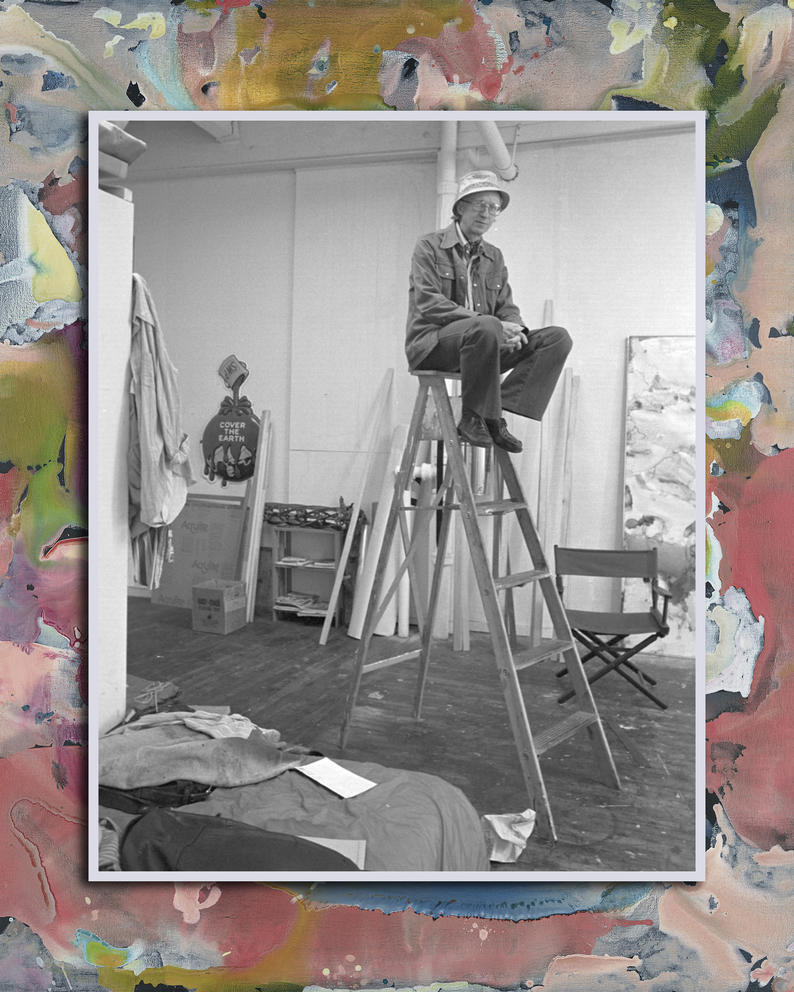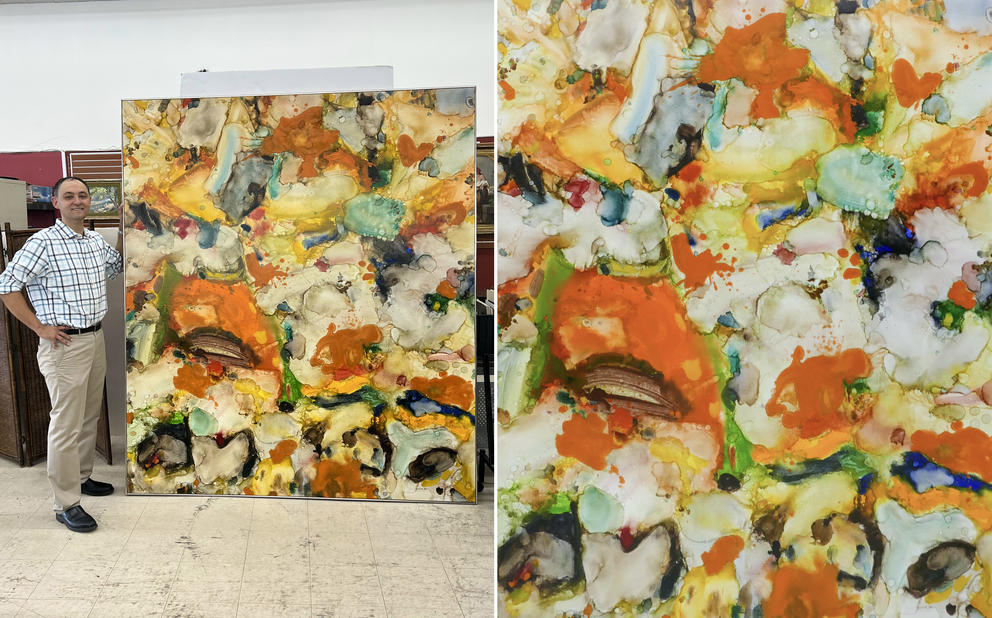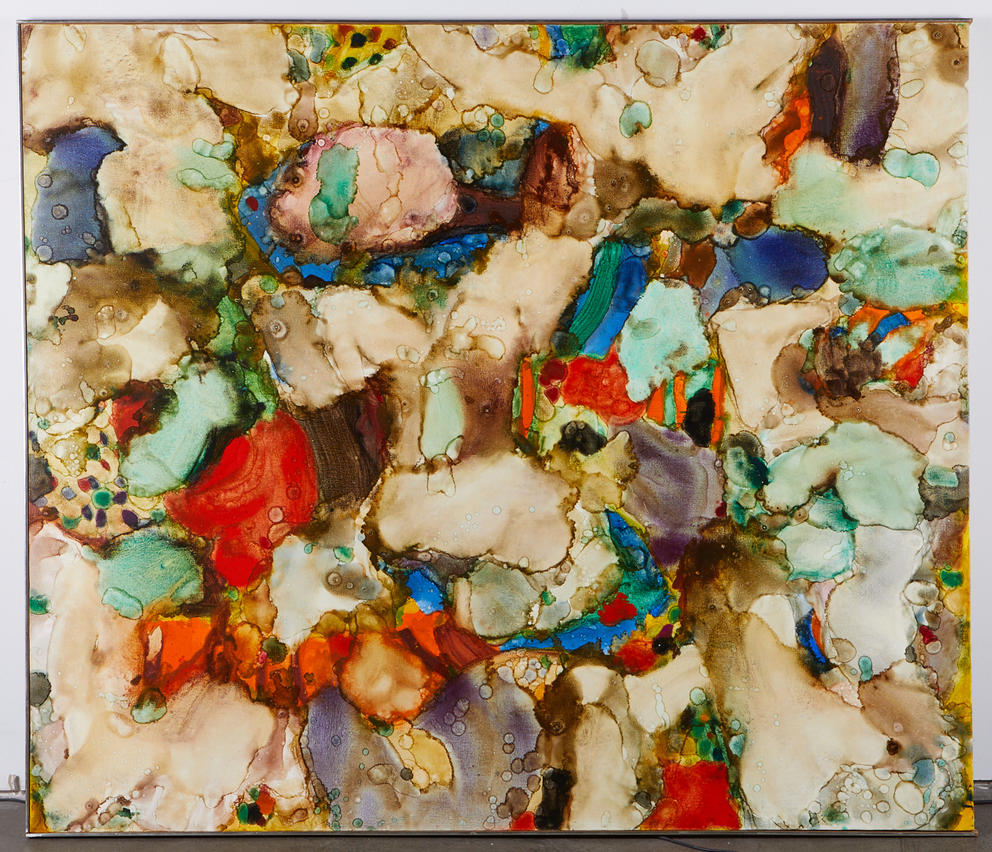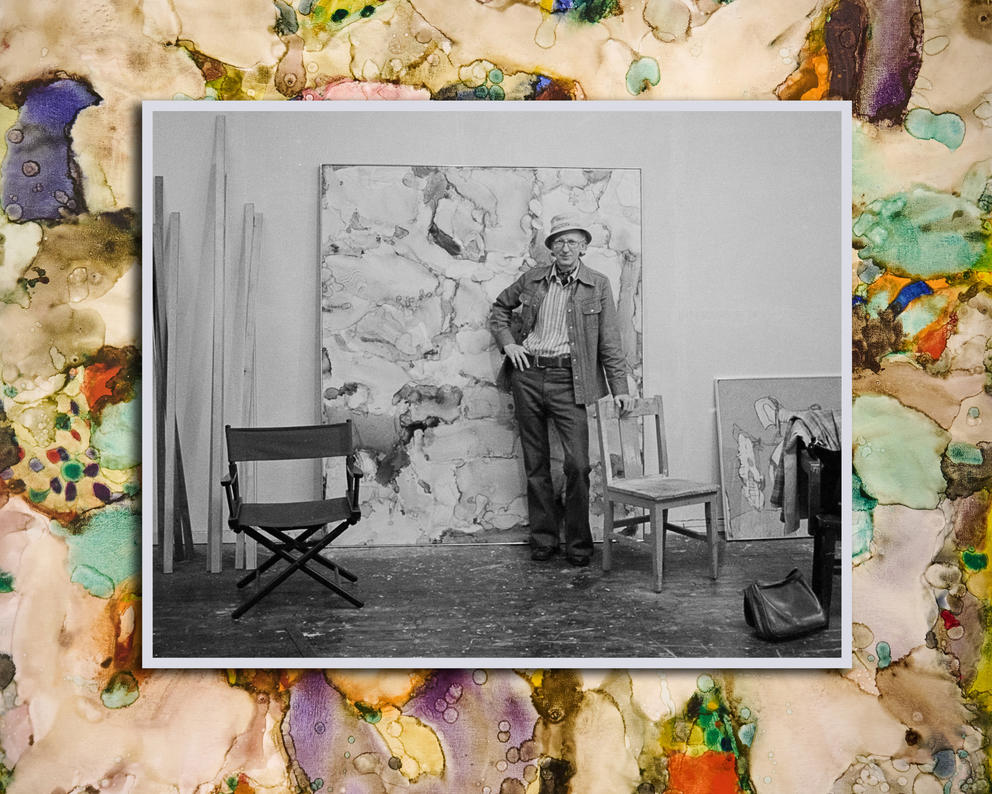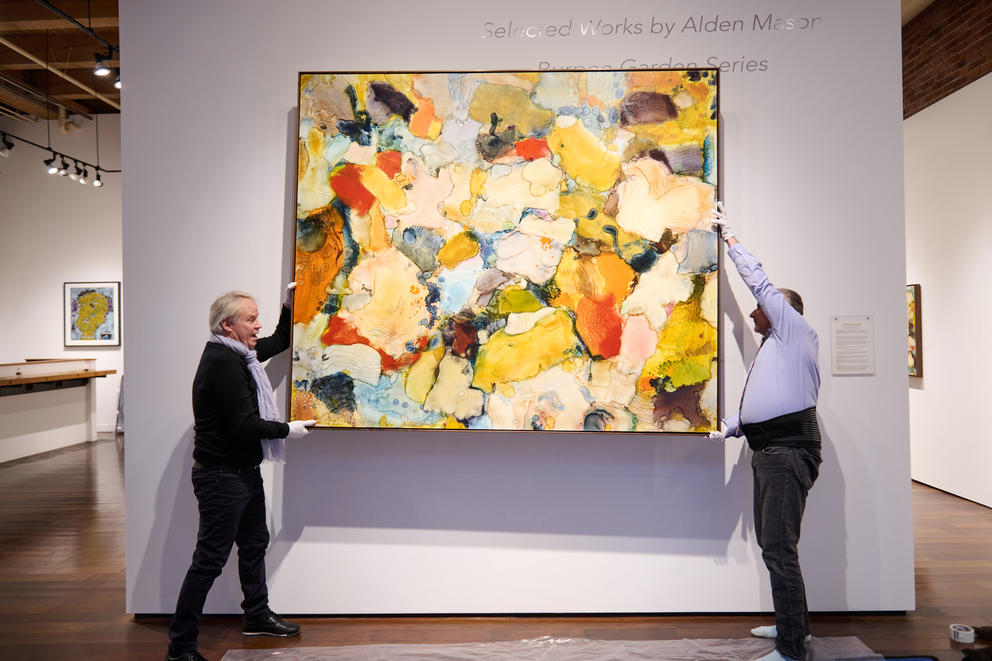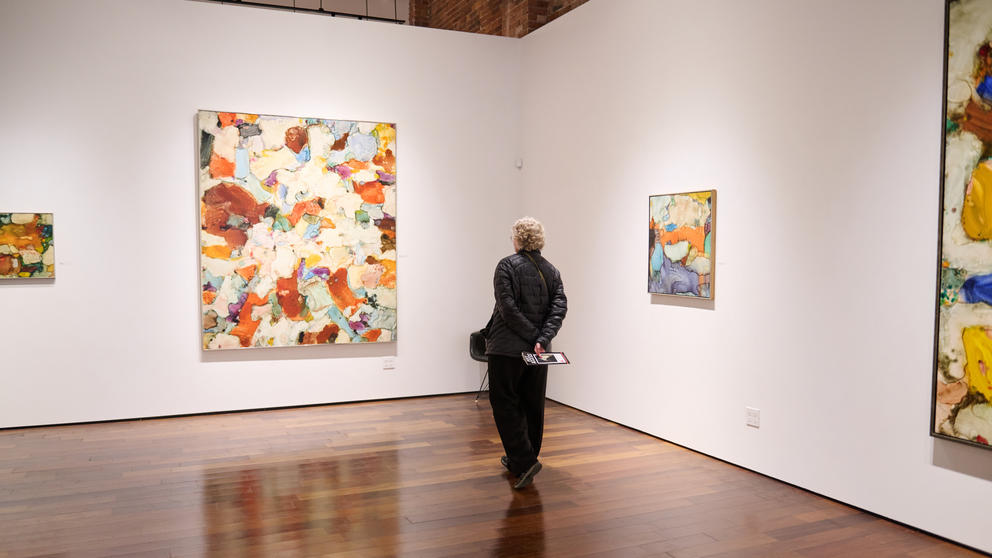Having recently retired to a small medieval château in the French countryside, Greg Kucera — still active in the eponymous Seattle gallery he ran for 38 years — closed his New Yorker magazine and opened the laptop sitting next to him on the bed. He navigated to LiveAuctioneers.com and typed in “Alden Mason,” the name of the late Seattle painter he’d represented for 13 years.
“Alden Mason: Oil Painting (1919-2013),” the auction listing read, next to an image of a tall abstract painting crowded with tightly packed red, beige and yellow clouds. Estimate: $20,000-$60,000.
To Kucera, it was obvious in just a few clicks: This was no Alden Mason. “Curious. !!” Kucera replied to the tipster, fellow Seattle art dealer John Braseth, of Woodside/Braseth Gallery.
It was curious: A painting, allegedly created by a Seattle artist who had died 10 years ago and never quite achieved international success, suddenly shows up for sale in 2022, on an online auction website by way of a Madrid gallery? A painting that Kucera had never seen before, in all his years as a gallerist?
Kucera and Braseth, along with Phen Huang of Seattle’s Foster/White Gallery, have been selling paintings by Alden Mason (1919-2013) for decades, placing his artwork in the hands of trusted art collectors and museums. But in the months leading up to that December text message, something remarkable had happened: At auction, Mason’s paintings had begun selling for previously unseen prices, reaching up to $189,000, more than double the usual.
Someone, Kucera suspected, had taken notice — and wanted in on the surge. “People are trying to cash in on our hard work,” he texted Braseth that night.
As midnight approached in France, Kucera composed an email to Huang back in Seattle. “How many things are wrong with this picture?” he wrote as he attached a link to the listing.
Huang responded that same day. “Sent it to the FBI art fraud contacts.”
“An absolute flirt”
Huang met Mason when she was a little girl in 1970s Vancouver, B.C., where her parents represented the painter at their gallery through the mid-1980s.
“He was very present to beauty in life,” says Huang, who became his Seattle gallerist with Foster/White in 2002 and now represents Mason’s estate at the gallery. Nature and travel enthralled him, she recalls: “Why we’re here, how it works, and how you can be part of the earth: That was a really strong driving force for him.”
Talking about Mason in her Pioneer Square gallery, Huang recalls his sense of playfulness, which was apparent to her even as a kid and later shone through in the way he approached the world. Once, Mason — an octogenarian by then — picked her up at the gallery in his tiny white car, which shook from the sheer force of Little Richard blasting through the speakers.
Through conversations with former friends and gallerists, a portrait emerges of a kind and curious man who possessed an inexhaustible joie de vivre and a goofy sense of humor.
“I am a bird watcher of sorts and a wanderer always looking for that perfect place,” Alden Mason wrote in unpublished notes from the late 1990s. “My mother always said, ‘There is no magical perfect place, no Shangri-La, and if there was, it could be anywhere you were at the moment if your head was screwed on properly.’ She probably was right, but sometimes the fun is in the search.”
Mason — who often sported a trusty bucket hat and a bandana around his neck — was a little like the birds he loved to watch through his binoculars: flitting around, forever looking for the perfect place to land.
Raised in the 1920s on a dairy farm in the Skagit Valley, Mason harbored a deep fondness for the polychromous abundance of bugs, birds and bulbed flowers of the agricultural oasis at the edge of Washington’s North Cascades.
Though he originally enrolled in the University of Washington’s entomology department, he abruptly changed course and switched to the art department after an epiphanic life drawing class. Years later he’d return to UW to teach, which he continued to do until he was 62, as his paintings brought him local renown.
Huang says his spontaneity showed up in those paintings. For a while he tried drawing with his eyes closed, to better tap into his instincts and unbind himself from the “rules” of representation.
It was just one of many formal experiments. During his career, the prolific Mason explored as many different styles as types of paint. He cycled through nearly a dozen art dealers (a list that reads like a who’s-who of Seattle arts, from Zoë Dusanne to Polly Friedlander to Greg Kucera). He was married three times and on various occasions dated former students. Which didn’t stop him from jokingly asking other women, including gallery assistants, to marry him until well into his 90s.
“He was an absolute flirt, and probably loved women as much as he loved painting,” wrote Seattle gallerist Judith Rinehart, who worked with Mason as a gallery assistant at Foster/White in the mid-2000s, via email. In a conversation with art history professor Roger Hull in the monograph Alden Mason: Paintings, one former student-turned-lover noted “He was so attracted to birds — moving on to the next, more beautiful [example]. This applied to people [too].”
Flirtation was evident in his approach to work as well: Mason’s early pastoral watercolors of local vistas in the 1940s gave way to abstract expressionism in the 1950s and a brief affair with pop art in the 1960s. In his later years, he conducted figurative experiments featuring giant heads and squiggly paint lines made with ketchup and mustard squeeze bottles.
In the early 1970s, Mason found yet another mode of painting. While resonant with the New York-based movement of color field painting, this was wholly his own.
These new, large-scale paintings — which he gave names like “Delightful Goofer,” “Cloud Catcher” or “Dandy Blusher” — were abstract, resembling a colorful crowding of cells or a collection of pebbles on a beach, or maybe a field of flowers seen through narrowed eyes. He named it the Burpee Garden series, after the seed packets of the same name, an echo of his rural youth.
The canvases burst with tangerine and emerald and ochre and bubble with energy — a complete break from the dark and moody tones of his Northwest Mystic contemporaries. “His paintings were really about the vivaciousness of color,” says Kucera, who has organized various Burpee exhibits over the past decades. “Alden loved things that were growing; he loved things that were alive.”
Mason created this vivid effect by diluting oil paint with turpentine, stand oil, varnish, linseed oil and a host of other chemicals, which lent the paint a kind of watercolor consistency. To ensure the paint wouldn’t run off his canvases, he laid them on the floor of his studio, which was near what is now Seattle’s Olympic Sculpture Park.
Squatting or kneeling over the canvas — later kneeling on a purpose-built bridge — he’d pour his paint blend onto the surface and then spread it around with house-painting brushes, sponges and rags. “It’s about the paint blooming within its neighboring paint,” Huang says. “The mystery of the materials and how they interact was captivating for him.”
The Burpee series was his first major hit. After showing the paintings in Seattle’s Polly Friedlander gallery, Mason brought them to New York (with the help of former student and already-famous friend Chuck Close), LA and San Francisco. He’d finally captured the attention of a national audience.
But after five years, this triumph would come to an abrupt end. Mason’s breakthrough paint blend emitted a mix of toxic fumes that, as he hunched just inches over the canvas, gave him headaches, made him dizzy and caused breathing issues. His most successful work was killing him.
Anonymous bidders
$10,000. $14,000. $15,000. The ticker on the screen is multiplying dizzyingly fast. John Braseth can feel his heart beating as he clutches his paddle at the back of the Christie’s auction room in New York. It is November 10, 2022, the second day of the sale of the Paul Allen art collection, amassed by the late Microsoft co-founder and Seattle philanthropist. Multimillion-dollar masterpieces by the likes of Picasso and Gauguin have already sold, so the dimly lit room on the second floor of 20 Rockefeller Plaza is only half-full. But for Braseth, it is showtime.
$26,000. $28,000. $32,000. On the stage, the auctioneer is flanked by photos of the current painting up for sale: “Sweet Encounter” by Alden Mason, a lush abstract painting with blushing pinks and purples that he made in the Burpee style, but with acrylic paint, in 1978. A Christie’s employee wearing a blue scarf raises her free hand as she talks into her phone. She’s bidding for an anonymous collector. Braseth isn’t certain who he’s up against (but fellow art dealer Greg Kucera was also in the mix, bidding from France). $45,000.
Less than a minute later, another Christie’s employee puts a bid in for yet another anonymous client: $120,000. Braseth isn’t sure he can go any higher. Does he have a client willing to pay this much? “125?” the auctioneer asks him from her pulpit. “Sir, you’ve come this far,” she nudges. He sticks up his paddle. But seconds later, he has to bow out when another bidder goes to $135,000.
“Fair warning, then,” the auctioneer says. With one swift smack of her gavel, it’s over. Three minutes and seven seconds, that’s all it took for “Sweet Encounter” to sell to an anonymous collector for $150,000 — $189,000 with fees. An absolute record for Mason. (Christie’s declined to say who had purchased it, or whether the painting had sold to an institution like a museum, or a collector.)
It was the third in a recent string of auction records for the Seattle painter. In early August, the 1974 Burpee painting “Winter Zinger,” muted and earthy but speckled with blues and reds, went for an unprecedented price via a Minneapolis auction house.
“Alden Mason work rockets to record-setting $162K at Revere Auctions,” read a headline on Auction Central News, the blog of LiveAuctioneers.com. In that instance, Braseth was the winning bidder, acting as a broker for a Bellevue-based collector, he says. (“I thought I’d buy it for 60,” Braseth recalls, sitting in the private meeting room of his downtown gallery on a black Le Corbusier sofa. “I got caught in the frenzy.”)
Then, in September, “Orange Goofer,” a large and exuberant composition blooming with springlike colors, sold for $150,000 via the Renton auction house MBA (to an anonymous client of Greg Kucera).
Kucera thinks these recent records are why ABC Gallery suddenly advertised a painting by Alden Mason. “There’s no belief on my part that a painting of Alden Mason is going to show up on this kind of schlocky gallery website without this sudden catapult of interest in Alden’s prices,” Kucera said in a phone call from France.
The Allen sale wrapped up on November 10. ABC Gallery listed its “Alden Mason”-signed artwork on LiveAuctioneers.com within a month.
Red flags
Back at the castle, Kucera scrutinized the painting peering back at him from the laptop screen in his darkened bedroom. ABC Gallery was trying to pass off this painting as a true Burpee, he figured. They’d even given it a plausible name, he thought: “Soft Cradle,” written in all caps on the back of the canvas along with Mason’s “signature” in naive cursive and the words “mix oil.” (“Soft Cradle” is the name of a muted Burpee painting Mason made in 1974.)
For Kucera, there were too many red flags. The size wasn’t right: Mason wouldn’t have used canvases sized in half-inches. The painting looked unprimed, but Mason heavily prepared his canvases with layers of white gesso (a chalky paint) so that his paint mixture wouldn’t soak in but rather floated on the surface. And Mason would have never stretched a canvas like this, with stretcher bars and tacks rather than staples — Kucera would know: He’d worked as Mason’s studio assistant for four years before becoming his gallerist.
But there were more intangible clues, too. “The paint areas just have no spontaneity to them,” Kucera wrote in an email. “There’s no music to the arrangement; no jazz to the elements. It’s a studied painting by someone who’s trying to recreate what Mason did just by looking at digital images.”
Fellow Alden connoisseurs Huang, Braseth and Cascadia Art Museum curator and Pacific Northwest art historian David F. Martin agree. “It’s a terrible painting,” Martin wrote in an email, “no way that Alden painted that mess.”
Kucera thought so, too. So he emailed ABC Gallery. Where had they gotten this painting? “Provenance: From a distinguished corporate collection, Washington,” someone named “Julissa” wrote back to Kucera in early December. “Hope you want to buy this painting. Pls let’s know,” Julissa added. Kucera followed up. Which corporation? “Diane Gilson Gallery in Seattle,” Julissa responded a few hours later.
Odd. That was the name of a gallery that closed in 1983, not one of the many corporations that had actually purchased Mason’s work during his lifetime. Kucera pressed again — and again the story changed. Now it was staffers who’d given Julissa incorrect information. The next day, she emailed again: The painting was actually painted in the style of the artist.
“Definitely this painting was not acquired in the gallery that was indicated, but rest assured that an artist with delicacy and good taste captured this painting in the best way and likeness, an artist who has the necessary knowledge to be able to transmit what the original artist wanted to do,” Julissa wrote.
Kucera doesn’t know when exactly the description of “Soft Cradle” changed online, but at some point “in the style of”’ appeared at the end of the listing, he says. “Which means that we don’t know for sure the origin of the painting, since we do not have certifiers of these works of art in my country,” the accompanying text reads. But the “Alden Mason” signature was still on the back of the painting.
Meanwhile, Huang, from her Seattle gallery, had alerted the FBI’s Art Crime unit. “I wonder if this is of interest, a fake Alden Mason painting listed for auction,” she wrote. “His older paintings, Burpee Garden Series works, have been getting amazing prices at auction lately.”
Asked whether the FBI’s Art Crime Unit had opened an investigation, a spokesperson for the FBI responded: “In keeping with DOJ standard practice, we neither confirm nor deny the existence of an investigation.” Spanish police did not respond to questions about the existence of an investigation.
Always almost
Art forgers have to strike a careful balance. Pick too unknown an artist and no one will bite. Opt for an art-world celebrity and collectors will see through your ruse. “If a new Monet hit the market today … there’s going to be a lot of scrutiny on that particular piece,” says Randolph J. Deaton IV, a special agent with the FBI’s Art Crime Team, which deals with forgery and fraud in the art market.
“When dealing with lesser-known artists, where there is no catalogue raisonné, where works typically sell on the low end, $10,000, $20,000 [and] there’s not a lot of research done on the materials and techniques used by that artist,” he adds, “that’s kind of prime for a forger to get involved and take advantage of that situation.”
Alden Mason’s sales might be just right, sitting in that Goldilocks middle range. He reached a level of success many artists aspire to, but never quite received the national acclaim he desired. He didn’t make a secret of the fact that he dreamt of fame beyond the invisible-but-impervious borders of the Pacific Northwest art scene, and would always mourn the fact that he never received a major New York museum show or local retrospective.
While he had two solo shows at the Seattle Art Museum in 1986 and 2011, a variety of showings in West and East Coast galleries plus a “selective survey” of his work at the Henry Art Gallery before he died, the big-ticket retrospective always eluded him. (At least in his lifetime; the Bellevue Arts Museum organized one in 2021, titled Fly Your Own Thing.)
“I think, had the Burpee series not been toxic to his health, Alden could have become as famous as Mark Tobey and the other Northwest [Mystics],” local art curator Lele Barnett, who worked with the artist in the early 2000s at Foster/White gallery, wrote via email. “He was brilliant with color and improvisation, but the Squeeze Bottle paintings [which he made later] just didn’t have the same effect.”
“He felt that over and again, he’d almost be there and something would get in his way,” says Huang. “A gallery would close, or he could no longer make Burpee paintings — and there was a big shift that had to happen.”
“He gave a lot of serious thought and concerned thought to this whole matter of legacy,” says Hull, the art history professor who wrote an essay about Mason for the monograph. “My impression is that selling those Burpee paintings for hundreds of thousands of dollars a decade after his death would astonish and please him.”
And yet. Mason’s feelings about his Burpees were complicated: He feared that whatever he’d do next would never compare in critics’ eyes. And while the series was a commercial success — he sold out two shows at the Polly Friedlander gallery in the early and mid-1970s — he barely made any money. When Friedlander shuttered her gallery in 1978, bankrupt, she owed him roughly $20,000 (about $91,000 in today’s dollars). Mason would never see that money.
“My God, I could hardly sell a painting in the first 10 years when I was teaching, and now they’re at $41,000,” Mason said in a 2008 interview about his Burpee paintings. “And one of them’s going to the lobby of the new Four Seasons hotel, the posh hotel they’re building across from the art museum. So, things change.” He didn’t have any idea how much — in terms of his prices, by more than twofold.
A year or two ago, a large Burpee painting would have sold for about $85,000. While prices for all styles of Mason’s work had been steadily increasing in the past 15 years, the recent auction sales are a remarkable leap.
This is in part due to a limited supply: Mason is not making work anymore, and collectors are likely to hold on to the paintings they do have by him. Burpees are especially limited, as Mason made them for only five years. (“No one knows exactly how many he created,” Braseth says, but dealers now think there were roughly 70 to 80 large-sized Burpee paintings.)
“Burpees are really quite attractive,” Huang says. “To be able to say that you have one is a big deal. So there is a little ‘keeping up with the Joneses’ happening in there.”
For sale in Madrid: Silver and gold and a dubious painting
At 113 Paseo de las Delicias, a three-lane avenue in central Madrid, you can see silver necklaces garlanding mannequin torsos, rings and other jewelry shimmering in the window displays, visible on Google Maps. “COMPRO ORO” (“I buy gold,”) a sign reads. “Plata Y Oro” an LED screen announces. There is no art gallery in sight.
When asked by Crosscut why the address listed as ABC’s on the LiveAuctioneers.com website leads to a gold and silver store, a representative for ABC Gallery (who signed her correspondence “Julissa”) wrote in an email that the gallery “does not have an exhibition gallery for the lots we sell, we have warehouses in different parts of the world.”
Other questions from Crosscut about the gallery and the Alden Mason painting went largely unanswered. But from an email from ABC Gallery to Kucera, some clues emerge: The ABC in ABC Gallery seems to stand for Alfaraz Business Consulting SL, which is also listed on LiveAuctioneers.com under yet another street address that, if you type it into Google Maps, leads to a restaurant.
Notable: A person named Julissa resigned from the business last year, according to Madrid business licensing documents, and a new person took over. That person started a new business just this past February: Canvas Sea Blue Art, which has already shown up on LiveAuctioneers.com (so far without any listings).
Adding to the intrigue is that the Alden Mason painting isn’t the only thing ABC Gallery is selling. In the same auction, ABC offered works by “Andy Warhol,” “Paul Gauguin” and “Picasso” — all estimated at under $50,000. Blatant forgeries, according to Kucera. “What you’re doing with this auction full of fakes and badly researched paintings by Gauguin and Kahlo and so many others is really a sham,” he wrote Julissa. “It’s wrong. It’s crooked.”
In an email to Crosscut, Julissa wrote: “We make our purchases in antique houses, virtual platforms, markets and directly to people who wish to sell us. In some opportunities, we buy with supporting documentation and in many others without any document, which is why our prices are low.” She also wrote: “in our descriptions and conditions of sale, we clearly consider that the majority of the lots are ‘In the style of the artist’, since sometimes we do not know for sure the origin of these.”
Meanwhile, ABC has marked the “Alden Mason” painting as “sold.” In the same email to Crosscut, Julissa wrote, “Our purchase / sale information is confidential, we respect the rights of buyers.” But when art dealer Greg Kucera asked, she responded: “That painting was not sold nor will it be sold, I decided to keep it as part of my collection, it is very beautiful.”
Investable assets
While fakes and forgeries are not new phenomena, the rise of e-commerce has made it a lot easier to sell them, says Adrienne R. Fields, a New York lawyer who often represents artists in intellectual property rights cases. “It’s this ease of transaction [that] lends itself well to this type of activity,” she says. “They reach a larger demographic, including inexperienced buyers.”
Trying to get those fakes off the platforms, she says, “is like cutting the head off the Hydra: one comes down, and several more are posted within minutes or days… There are ways to take them down. But it’s a lot of work for everyone involved.”
A complicating factor: Many aggregator websites and sales platforms take the position that they’re just a passive conduit, “that they are merely a platform that allows sellers to interact with buyers, to shield themselves from liability, and provide a forum where sellers can hide,” Fields says. (LiveAuctioneers did not respond to questions, but in an emailed statement said that it “provides a bidding platform and marketing services to auction houses worldwide. We neither own, store or ship the goods listed on our site.”)
And as long as the art-market growth continues apace, says Georges Lederman, a former prosecutor and New York attorney known for representing clients who have been accused of or are victims of art crime, we’ll see the number of fakes and forgeries grow accordingly.
“Art isn’t just art anymore, it has become an asset class,” Lederman says. “And because it is something that one can invest in, one can get a loan against, one can fractionalize and sell — and because of the increase in value in art relative to the stock market — there is an increase in art crime. And as long as the art market continues in this way, as long as art continues to be an investable asset, criminals are not far behind.”
$65.1 billion in art sales
Propelled in part by increasing wealth inequality, the power of the internet and an expanding collector base in Asia, the international art market has seen explosive growth in the past decades.
In 2021, global sales of art and antiques at dealers and auction houses reached a total of $65.1 billion, according to the Art Basel UBS 2021 Art Market Report, surpassing pre-pandemic levels (but not quite reaching its absolute peak of $68.2 billion in 2014). Total sales conducted by auction companies, including both public and private sales, were estimated to have reached $30.4 billion in 2021, up 10% from 2019.
Numbers for 2022 are not yet available, but it’s safe to say that Paul Allen’s Christie’s sale will comprise a major chunk of the tally. Totaling $1.6 billion (including fees), the auction of his collection set the record for the most expensive single-owner sale.
It leaped over previous records, including the sale of the art collection of Harry and Linda Macklowe ($922 million) and Peggy and David Rockefeller ($835 million) in previous years. An unprecedented number of paintings, like Georges Seurat’s “Les Poseuses, Ensemble (Petite version)” and Paul Cezanne’s “La Montagne Sainte-Victoire” went for more than $100 million each.
Amid these art-world all-stars, Alden Mason’s painting — which used to hang in the street-level lobby of Paul Allen’s Vulcan offices in Seattle’s Chinatown-International District — was a bit of an odd man out. One of two pieces by Seattle artists on the block, the work was estimated at a mere $3,000-$5,000 (which some argue was a lowball designed to instigate a bidding frenzy).
That it went for much more than that, and blew away Mason’s previous records, was in part thanks to the lot’s storied pedigree, having belonged to a billionaire who’d assembled a museum-worthy art collection. Suddenly Mason was rubbing shoulders with Manet, Seurat, Cézanne, Van Gogh, Lucian Freud and Georgia O’Keeffe.
“There was something about it having the cachet of Paul Allen’s name on it,” Huang explains. “[Allen] not only owned Alden Mason but [also] all the other bigger names from [the] Western art-history world. So there’s also a little bit of a feeding frenzy that they were playing with.”
Or, as Greg Kucera puts it: “‘I got that at the Paul Allen sale’ — that sounds pretty good when you’re at your dinner table with some fancy guests. Rolls right off the tongue. And it doesn’t cost you as much as buying the Matisse or the Picasso or the Monet.”
John Braseth, director of Woodside/Braseth Gallery, and associate director Tony Erwin (right) remove Alden Mason’s “Orange Bingo” (1976) from the wall for packing and transport to a collector. Braseth wrote via text that Mason was a “wonderful raconteur,” and adding: “Little wonder everybody felt important being around him.” (Chona Kasinger for Crosscut)
Record gallery prices
It’s unclear where the Mason painting from the Allen auction ended up: Seattle art dealers haven’t heard anything through the grapevine and suspect it may not have been a local collector who purchased it.
But at least one recently auctioned Mason painting, “Winter Zinger,” has shown up back in Seattle, at Woodside/Braseth, which represented Mason in the 1990s and has hosted various exhibits of his work since the 1960s. Gallery director John Braseth showed the work in January with more than a dozen other Burpee paintings he’d borrowed from local collectors to showcase.
As with “Winter Zinger,” most of the works were not for sale. But the seven Burpee works that were (Braseth convinced a few collectors to part with their Burpees) all sold “for record prices,” Braseth says.
At the gallery, one went for $200,000 and one for $220,000 — up significantly from the auction records from the past year. The prices were so high (and so many of the pieces were on loan) that the gallery had to get supplemental insurance.
But will these prices last, or is it just an extraordinary spike? Do three unusual market circumstances plus an art show make a trend? Is the Mason fascination a fad or a fixture?
Huang is not sure. Sitting at a round table in the dim upstairs exhibition room in the spacious Foster/White Gallery, she gets emotional. She’s in the business of selling art, yes, but the purely financial calculations never sat well with her. “For me, buying art, living with art, is about a quality of life,” she says, tears welling in her eyes.
When Braseth had a show so soon after the auctions, she felt he was engaging in a “different game,” she says. “It’s playing with the auction game.” (Braseth says the show started as a celebration of Mason’s work and only later became a show where some paintings were for sale.) It makes her uncomfortable too that the success — and interest — in Mason’s work is coming so long after Mason’s death.
A visitor looks at the work of Alden Mason at Woodside/Braseth Gallery on February 8, 2023. Mason “knew he was capable of greatness, but national fame eluded him,” gallery director John Braseth wrote in a text message. “He would have really enjoyed the attention that comes from the... notoriety and prices paid for his work, especially the sale of ‘Sweet Encounter’ at the Christie’s Auction.” (Chona Kasinger for Crosscut)
This newfound financial success doesn’t benefit Mason or his foundation, notes Stephen McClelland, a former friend of Mason’s and now co-chair of the Alden Mason Charitable Art Foundation. Because of Polly Friedlander’s bankruptcy, “Alden saw no money from these [Burpee] works and because we have no laws as in Europe for resale, he, his family or the foundation will see no money from any resale,” McClelland wrote in an email.
“So who profits from work that Alden received nothing for? … the collector and the dealer who markets the resale,” McClelland wrote. (“For this show, I took a very low commission of 25%,” Braseth said via text message, noting that with overhead, he barely made any money on this show.)
Huang thinks that for this reason, Mason would’ve probably felt ambivalent about this recent surge in sale prices. On the other hand, she says, he would have enjoyed the attention and the celebration of his work. “He’d be stoked to have a broadening influence. That what he spent his life doing was worthy of attention,” she says.
Or maybe Mason would have his eye on a different horizon altogether. “When I talk to other people, I don’t talk about painting at all,” Mason said in a 1975 interview for the University of Washington. “The whole thing is kind of strange in a way. What I talk about is fly fishing or some secret mountain lake or skin diving some place or places in Mexico I’ve been.” Ever the wanderer, looking for that perfect place to land.
This story was updated to reflect that John Braseth did not learn of Kucera’s involvement in the Paul Allen Christie’s auction after the fact.
Crosscut Arts & Culture reporter Nimra Ahmad contributed research for this story.
Listen to reporter Margo Vansynghel discuss this story on the Crosscut Reports podcast:
Get the latest in local arts and culture
This weekly newsletter brings arts news and cultural events straight to your inbox.

